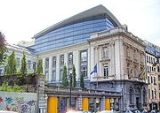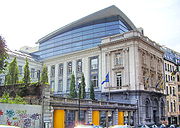
Brussels Parliament building
Encyclopedia

Brussels Parliament
The Parliament of the Brussels-Capital Region , is the governing body of the Brussels-Capital Region, one of the three regions of Belgium...
.
Architecture
The hemicycleHemicycle (chamber)
In legislatures, a hemicycle is a term for a semicircular, or horseshoe shaped, debating chamber where deputies sit to discuss and pass legislation. Though composed of Greek roots, the term is French in origin...
is on the top floor of the building, with the roof being of modern zinc and glass design. The chamber is encircled by a long curved wooden wall and there is an overhanging press and public gallery. Committee rooms have likewise been updated with modern technology but much of the building remains neoclassical. There is also a cafeteria and reading room for deputies. The four rear wings have administrative functions, including housing the Presidents offices. There is also 400 square metres of hanging gardens extending to heights of up to 27 metres.
History
Towards the end of the seventieth century, the site housed the vast mansion of the Maes family on the rue de Chêne. This was destroyed in 1695 by Louis XIV during his bombardment of Brussels in the War of the Grand AllianceWar of the Grand Alliance
The Nine Years' War – often called the War of the Grand Alliance, the War of the Palatine Succession, or the War of the League of Augsburg – was a major war of the late 17th century fought between King Louis XIV of France, and a European-wide coalition, the Grand Alliance, led by the Anglo-Dutch...
. The remains of the mansion and its lands were bought by the Count
Count
A count or countess is an aristocratic nobleman in European countries. The word count came into English from the French comte, itself from Latin comes—in its accusative comitem—meaning "companion", and later "companion of the emperor, delegate of the emperor". The adjective form of the word is...
of Limminghe, Charles van den Berghe, who held numerous posts of administration in Brussels, being twice burgomaster of the city (later mayor). A year later in 1696 he built another large, prestigious two-story mansion at the end of an enclosed court yard with a garden (entered via Saint-Jean/Sint-Jan). This was then sold on to various figures such as Apostolic Nuncio and the then-ambassador to England.
It was acquired by the state for the first time in 1823 when the Brabant Province
Province of Brabant
Brabant was a province of the United Kingdom of the Netherlands from 1815 until 1830 and a province of Belgium from 1830 until 1995, when it was split into the Dutch-speaking Flemish Brabant, the French-speaking Walloon Brabant and the bilingual Brussels-Capital Region.-United Kingdom of the...
and the Dutch
Netherlands
The Netherlands is a constituent country of the Kingdom of the Netherlands, located mainly in North-West Europe and with several islands in the Caribbean. Mainland Netherlands borders the North Sea to the north and west, Belgium to the south, and Germany to the east, and shares maritime borders...
State bought it to house the Brabant government and act as the official residence
Official residence
An official residence is the residence at which heads of state, heads of government, gubernatorial or other senior figures officially reside...
of the local governor. This situation continued after the independence of Belgium
Belgian Revolution
The Belgian Revolution was the conflict which led to the secession of the Southern provinces from the United Kingdom of the Netherlands and established an independent Kingdom of Belgium....
in the 1830s however due to development of the provincial government the building became too small and dilapidated by the end of the 1860s. Hence there were successive waves of reconstruction - albeit with a planned design for consistency. The governors residence began to be modified in 1885 and in 1907 the office wing was replaced. Georges Hano, the then-architect for the Ministry of Public Works, built a higher wing with direct access to the rue de Chêne/Eikstraat. The different buildings were also interlinked and the façades overlooking the courtyard were unified. The governors residence was increased one story on the side facing the courtyard and the height was also increased on the building surmounting the porch reconstructed by Hansotte. The new rue du Lombardstraat was opened up by the city at the start of the twentieth century and Hano desired to make the presence of the provincial government felt on this new road which the his complex now bordered. In 1913 works began on a new building, completed in 1930, in a neo-Louis-XVI-style with a ceremonial entrance hall and lavish decoration.
In 1995, Brussels was split from Brabrant and given its own regional government. The Federal government gave the building to the Brussels-Capital region who gave it to the Brussels Regional Parliament, who were searching for a seat. However it became apparent that the buildings were unsuited for the role of a Parliament, leading to the opening of an architecture competition later that year. The resulting changes made including increasing the height of the building wing that overlooked rue du Lombardstraat in order to erect a new hemicycle there on the top floor. This added a large modern roof element to the neo-classical design of the building. Committee rooms were given modern equipment and state rooms were restored. Despite the renovation to the building, the original dimensions have been retained. There was also a multipurpose hall built beneath a hanging garden to create a link between the different sections of the building.
Art
Since being taken over by the Brussels Region, the building has hosted various modern works of art. This is maintained by a commission who purchase the works for the Parliament. The Commission is composed of members of the Parliament Office together with eight external observers from the art world. In 1998, this commission entrusted 11 artists to create works for areas of the building;- Yasmina Assbane for the floral kerchiefs
- Rudy Bogaerts for the artistic area dedicated to the memory of famous personalities
- Patrick Corillon for the "Three stories of Oskar Serti".
- Paul DayPaul Day (sculptor)Paul Day, born in 1967, is a British sculptor. His high-relief sculptures in terracotta, resin, and bronze have been exhibited widely in Europe and his work is known for its unusual approach to perspective.Major works include:...
for terracotta high-reliefs - Wim DelvoyeWim DelvoyeWim Delvoye is a Belgian neo-conceptual artist known for his inventive and often shocking projects. Much of his work is focused on the body. He repeatedly links the attractive with the repulsive, creating work that holds within it inherent contradictions- one does not know whether to stare, be...
for the "Love letter from Mohammed to Caroline" - Gilbert Fastenakens for the photos transferred to canvas
- Joseph KosuthJoseph KosuthJoseph Kosuth , is an American conceptual artist. Kosuth lives in New York and Rome.-Early life and career:Kosuth was born in Toledo, Ohio. He attended the Toledo Museum School of Design from 1955 to 1962 and studied privately under the Belgian painter Line Bloom Draper. In 1963, Kosuth enrolled at...
for the illuminated frieze - Guy Leclercq for the re-mounted canvasses
- Michel Mouffe for a set of mirrors and illuminated blocks
- Richard Venlet for the drawings of the electrical installations
- Julien Willem for the Brussels portrait gallery
See also
- Brussels ParliamentBrussels ParliamentThe Parliament of the Brussels-Capital Region , is the governing body of the Brussels-Capital Region, one of the three regions of Belgium...
- Belgian Federal ParliamentBelgian Federal ParliamentThe Belgian Federal Parliament is a bicameral parliament. It consists of the Chamber of Representatives and the Senate . It sits in the Palace of the Nation .- Chamber of Representatives :...
(federal assembly - upper and lower houses) - Flemish ParliamentFlemish ParliamentThe Flemish Parliament constitutes the legislative power in Flanders, for matters which fall within the competence of Flanders, both as a geographic region and a cultural community of Belgium The Flemish Parliament (Dutch: , and formerly called Flemish Council or Vlaamse Raad) constitutes the...
(regional and community assembly) - Walloon ParliamentWalloon ParliamentThe Walloon Parliament , formerly the Walloon Regional Council , is the Parliament of the Walloon Region, commonly called Wallonia, one of the self-governing Regions of Belgium with Flanders and the Brussels-Capital Region...
(regional assembly) - Parliament of the French Speaking Community (community assembly)
- Parliament of the German Speaking Community (community assembly)
- Commission communautaire française (COCOF)
- Vlaamse Gemeenschapscommissie (VGC)

